Diving in the Indo-Pacific is a great way to see some cool and unusual underwater creatures, but if you come across a lionfish it might not actually be a lionfish all time. It might be another species, the mimic octopus. The mimic octopus is an ocean-dwelling creature. It mimics many different animals in order to catch prey, and might possibly appear like a lionfish to someone who dives in waters where lionfishes are not typically present. If you ever get the chance to go diving in Indo-Pacific waters, keep an eye out for the mimic octopus.
Aside from being highly intelligent, octopuses are also quite charismatic. One of the most striking abilities is the potential for mimicking color, texture, and behavior of up to 15 different animals. They can do this no other animal in the world can do. There are more than 300 different species of octopus. While most octopus species spend their time hiding from predators, a certain type of octopus (mimic octopus) can hide right in plain sight by copying the appearance of other animals they come across.
1Its Scientific Name Is Thaumoctopus Mimicus
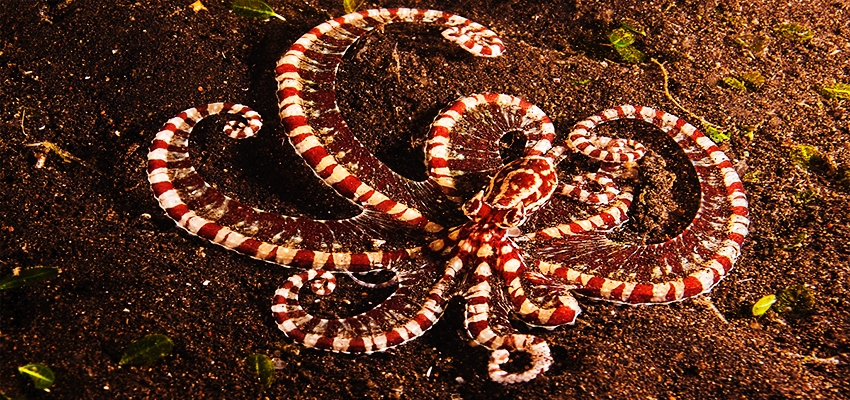
In 1998, the mimic octopus was discovered to be distinct from all other octopuses with a study naming it the “Thaumoctopus Mimicus”. Although it wasn’t given the species name until 2005, the mimic octopus is unique (only one octopus) in its genus. Their scientific name comes from their ability to impersonate other animals they encounter while they are still in the water shell.
2 Mimic Octopuses Have Incredible Abilities Like Shapeshifting And Camouflaging
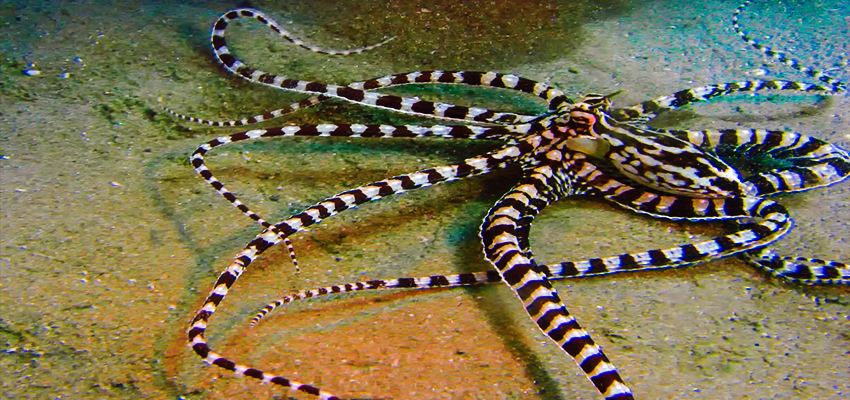
Octopuses are a type of marine animal that can vary significantly in length, depending on the species. Mimic Octopuses are small aquatic animals that only reach lengths of 2 feet (0.6 meters). Their mantle length can reach up to 2in (5.08 cm). That means their arms can be more than the length of their mantle, typically 7 to 10x longer because they’re really really long.
Not all mimic octopus shape-shifting is done to trick prey. Mimic octopuses have camouflage abilities, which means their arms can also change coloration for defense or for hiding better in their environment. Each octopus has its own unique pattern, even with regard to coloration or marking. It’s interesting to note that when a mimic octopus isn’t focusing on mimicking different animals, its arms appear pale to dark brown hues. Some have a range of white and brown stripes that run the length of their bodies, while others may have extreme mottling to their coloration instead of striping.
Mimic Octopuses can also be easily recognized by their mantle. It’s usually brown with chancy white colored markings. But, they also have a teardrop-shaped ring on the center or forefront of the superficial mantle. They also have a “U” shape in their dorsal, which is more visible in darker octopuses with light coloring.
One thing you’ll notice about octopuses is that their skin is generally quite smooth, which might let you take them for granted. However, they do have small bumps called “papillae” around the rim of the mantle and on each eye. These papillae not only protect their eyes, but also make it difficult for a predator to attack because of these long but sharp papillae towards the top of their eyes that help protect them. Mimic octopuses also have 283 suckers down their arms.
3 With A Specialized Type Of Cells, They Can Change Their Colors Seamlessly
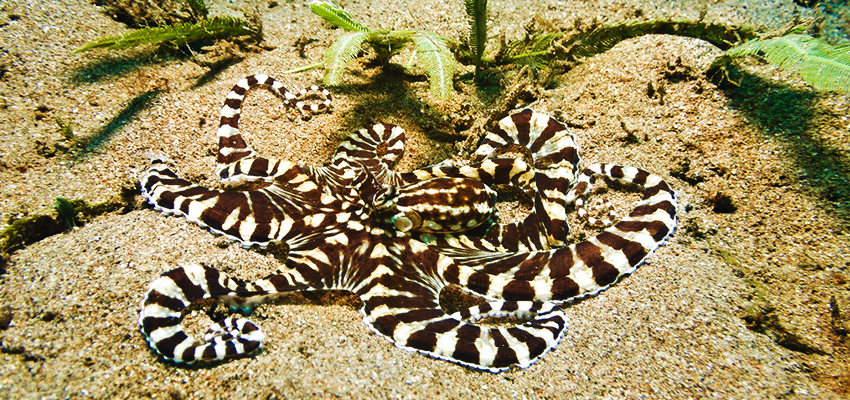
Color changes are a safety precaution for these intelligent Mimic Octopuses. When an octopus wiggles out of sight of a predator like a shark, they can change their color to blend in with the surrounding environment. An octopus is also able to change its color to not only match the nearby atmosphere but also mimic different animals that are too dangerous.
The specialized cells found in the skin of mimic octopuses are called “chromatophores”, and they allow them to change color seamlessly. They can even adjust the texture of their skin to more closely match their environment, making it arduous for predators to see them.
These octopus can mimic the movements of other animals by duplicating the actions of their arms. This makes them a difficult target to predators and predators may consider they’re not worth attacking and will move on to another probable prey.
4 With Chromatophores, They Can Shapeshift In Matter Of Seconds
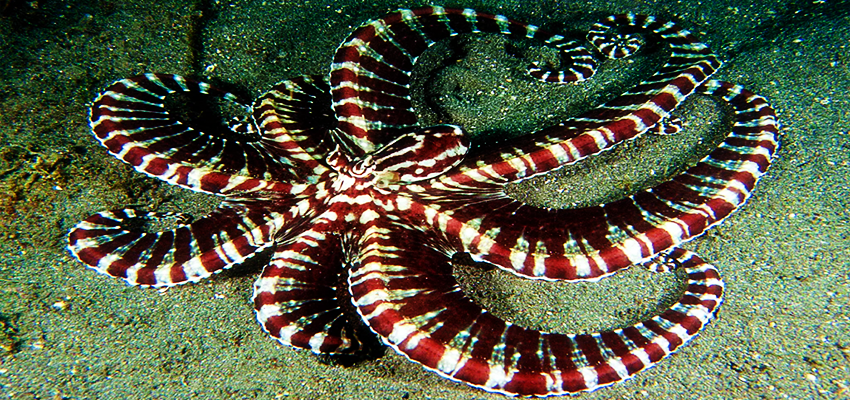
These Octopuses have cells called “chromatophores,” which contain pigments but they aren’t just there to make the octopus look awesome. These cells live deep within the skin and can actually change the octopus’s color (Appearance) so they blend into their surroundings. The distribution of these cells help to determine what colors or patterns will appear on an animal’s skin.
Chromatophores are present in many animals and allow them to change their color. The mimic octopus also has the ability to change its color and blend in nearly seamlessly with its surroundings but it seems extremely proficient with this talent.
These little cells are what allow the mimic octopus to change color by constricting rapidly. In a matter of seconds, it can transform into whatever pattern or shape it wants to imitate.
5 Mimic Octopus Can Impersonate Upto 15 Sea Species
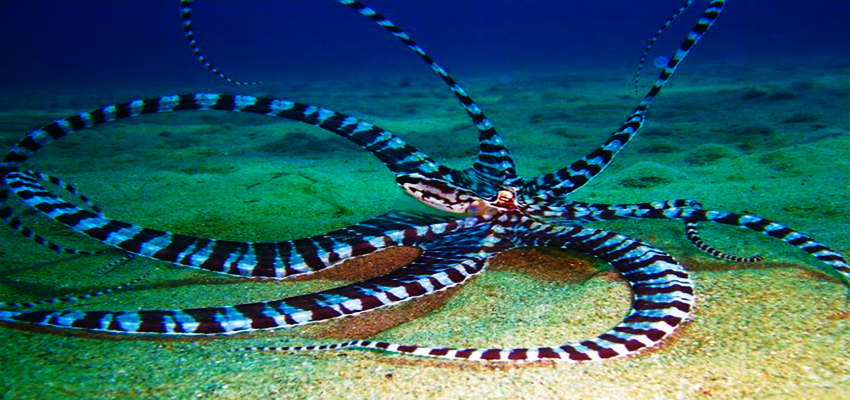
Most animals that can copy the appearance of other species are limited to one species they can imitate. Research has been documented that the mimic octopus is capable of copying up to three dissimilar species of animals.
Most divers recognize mimic octopuses as a talented mimic and claim that these octopuses can mimic many other species. They are experts at imitating other species and can even imitate them better than others. The majority of researchers think that the octopus could mimic up to 15 different species including the following:
Anemones
Stingrays
Crocodile snake eels
Nudibranchs
Sponges
Tube worms
Colonial tunicates
Jellyfish
Feather stars
Giant crabs
Mantis shrimp
Seahorses
When it comes to mimicking octopuses, they are very intuitive. They will use the same predators to defend themselves as variations of the predator’s presence that reoccurs over time. The mimic octopus can select which predators of the area they might imitate based on which one is currently nearby.
For instance, when a mimic octopus sees a damselfish, it is much likelier to imitate sea snakes because sea snakes are widely predator of these damselfishes and use their body type to fool the prey fish into thinking they are safe. This keeps the mimic octopus alive longer, so overall it’s an effective strategy.
Mimic Octopuses are also able to copy the coloration or movements of animals such as lionfish, sole (flatfish), and sea snakes.
Lionfish
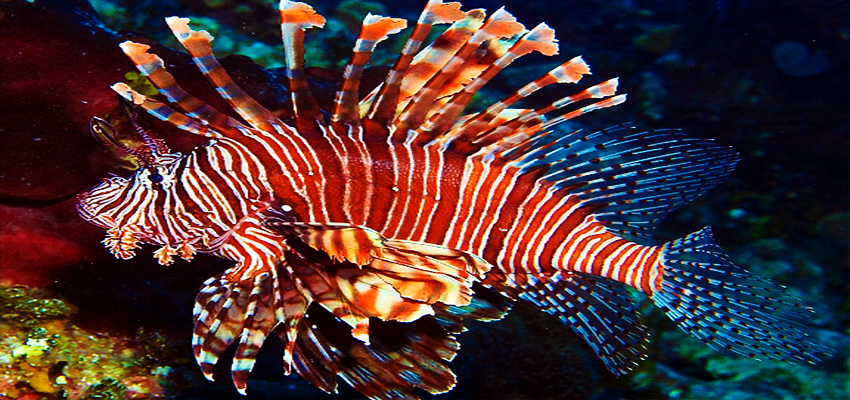
The mimic octopus has a clever way of protecting itself. It spreads out its arms to imitate the spines of the dangerous lionfish, which is what predators either stay away from or don’t want to get close enough to be attacked by the little guy.
The mimic octopus doesn’t have to change much in its coloration because, like the lionfish, it already nearly resembles its prey with brown and white stripes. That’s why there’s not more of a need for them to transform their current look.
Generally, Mimic Octopus can propel themselves through the water in two different ways. They can push off their abdomen, which makes them appear to be swimming through the water column. Or they can extend their arms and legs, which pushes them upward. But in this case they propel themselves through the water. This makes them appear to be swimming across the water column, just like the lionfish does.
Sole (Flatfish)
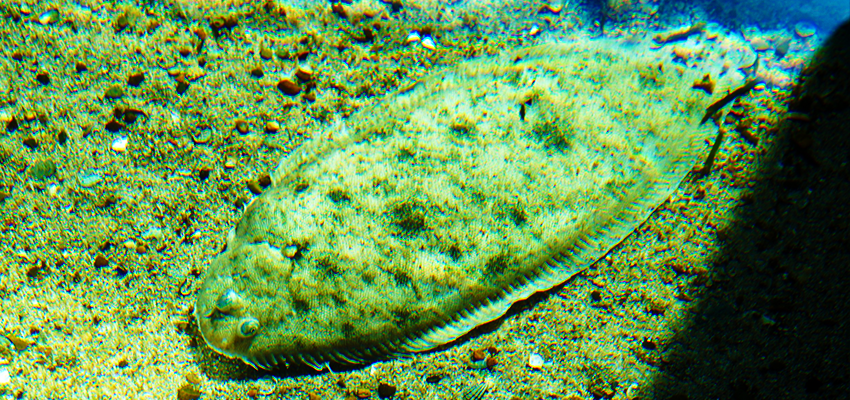
Octopuses have a strange ability to mimic the body shapes and behavior of other animals, including Sole Fish (poisonous). It’s not surprising that the mimic octopus mimics them. What’s no wonder is how the Mimic Octopus enjoys copying the movements of animals, one of their favorite preying tricks. The sole (flat, leaf-shaped) fish that can glide through the water. The mimic octopus has tactics that allow it to pull its arms in against its body. This flattens out its body so it can glide like a flatfish.
Sea Snake

When a mimic octopus encounters a sea snake, it will copy the predator’s coloration. This is helpful because some sea snakes are venomous and they could save themselves from harm if they were able to imitate the coloration of a harmless species like the mimic octopus.
When the Mimic Octopus is in need of a place to hide, it will pull its whole body into the burrow. Once inside, it will put two arms averse to the sand exterior. They can then use their arms to mimic a sea snake because of their black and white stripes as a sea snack, which deters predators and helps camouflage themselves.
Anemones
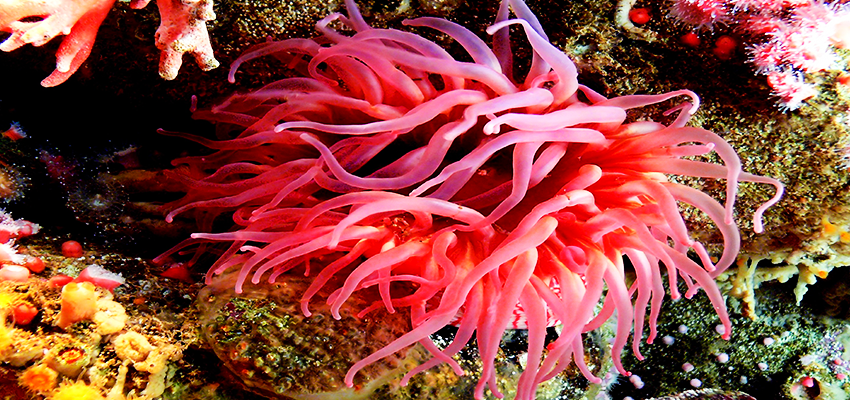
Scientists consider that the mimic octopus can mimic large, poisonous sand anemones in order to fool predators. Instead of sitting on top of sand with its arms stretched out like usual, it will sit on sand with its arms raised above its head in every direction.
Crabs
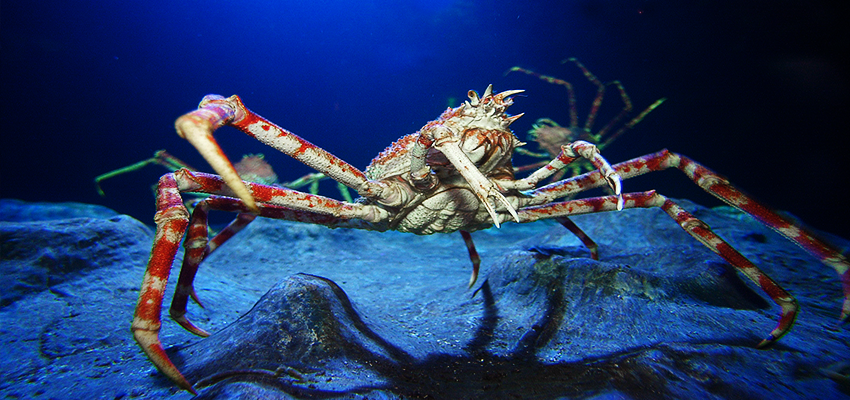
Mimic Octopuses have also been observed mimicking the mating behaviors of crabs. This is thought to entice over a probable mate with the hope of distracting them from the environment and luring them into a false sense of security. Once they are close enough, octopuses will then attack and devour their victims.
6 Where Can We Find Mimic Octopus In The World?

One of the many fascinating sea creatures that thrive amidst warm waters is the mimic octopus, who was discovered in the year of 1998 in the Indo-Pacific. This animal lives in the southwestern Pacific Ocean where the waters are sunny because it’s near the tropics. It’s also referred to as the mimetic octopus because it would change colors and shapes, depending on what predators it was actively trying to avoid.
The mimic octopus lives in the northeastern area of Australia and can be found from the north all the way through Papua New Guinea and New Caledonia. They also live in Indonesia, and reach northward into the Philippines, westward to the Red Sea.
7 They Can Survive Within 121ft Below The Sea Surface Level
Mimic octopus are most comfortable in shallow water with sandy or silty bottoms. They typically live between 1.5ft (0.5m) to 121ft (37m) below the surface in seawater habitats. These habitats typically include the mouths of rivers and outfalls, where there is a large concentration of food which can help them survive.
Octopuses are often found in the reef habitat where there are enough spots to hide. The habitat of the mimic octopus doesn’t provide them with enough hiding spots. There’s a reason why they’ve evolved their mimic strength. It’s an effective mechanism for staying safe in environments where it’s hard to hide. Not only are they outstanding diggers, but Mimic Octopus will sometimes find and use small animal burrows to build their own home. If they don’t feel like building their own home, the octopus may steal one from nearby worms, fish and crabs.
8 What Do Mimic Octopus Eat?

All octopuses put an emphasis on eating a wide range of small, aquatic animals to live long and prosper so we can easily say that they are carnivores and prefer to eat anything they can catch. They especially love consuming their favorite foods like crustaceans, echinoderms and worms.
Although mimic octopus are primarily benthic species living on the bottom of the ocean. They spend their time searching the underwater floor for prey. They even have the ability to stick their long arms into burrows in order to snatch out their following meal. After sticking their arm into potential prey’s den, they pull back and quickly produce a web to ensnare the victim.
Though it’s not clear how the octopus actually does this, the mimic octopus has been seen hunting through whole tunnels in the sand. Scientists have witnessed these octopuses enter by way of one hole, and come back out another with their catch.
9 Mimic Octopuses Are Great Burrowers
Remember when the mimic octopus can hide inside a shelter in order to imitate a sea snake? Octopuses are expert burrowers and diggers that can mimic sea snakes. Thanks to their amazing camouflaging skills, they’re also excellent at blending in with their surroundings. With a no-fear attitude, Mimic Octopus has the ability to dig underground tunnels and even run through them to reach food. They’re even brave enough to stick their limbs inside arbitrary holes in the ground and search for food.
Well known for their natural abilities to turn their skin into many different colors and textures, octopuses are usually nocturnal. The mimic octopus is an incredibly agile and well-camouflaged creature that moves throughout the day, despite its preferred time for nighttime.
When the Mimic Octopus needs to rest? it usually does so in a way that prevents getting eaten. They’ll find an area with a sandy substrate, and use it as protection.
Spending time in the burrows during the night gives Mimic Octopuses an opportunity to rest. During the day, they burrow themselves deep under the sand with only their eyes exposed. This allows them to move quickly and effectively when threatened by predators and also makes it easier for them to watch what’s happening so that they can rest.
10 How Do Mimic Octopus Reproduce?

Anything’s possible with octopuses! A male mimic octopus will use its hectocotylus (specialized arm) in order to transfer a sperm packet to the female (spermatophore) while mating.
Males are known to deposit their sperm directly into the female’s mantle cells for reproduction. Males can place their hectocotylus into a female’s mantle cavity to use it to transfer their sperm. They may also hand over their spermatophore directly to the female. The female will keep it safe until she is ready to fertilize it.
But, like other octopus males that have mated over their lifetime, the mimic octopus male will eventually lose his ‘hectocotylus’ after mating. However, they normally live for a handful months after mating and die as part of the mating process. Likewise, A female will lay eggs and then die shortly after. The female will have the usual symptoms of broodiness throughout the rearing such as guarding their eggs for predators. Shortly before they hatch though, her health descends until she dies. If a juvenile octopus hatches, it will live and grow in a planktonic cloud. This cloud will form surrounding the surface of the ocean.
They utilize all their energy eating in order to grow bigger as much as possible. Because of this, the smaller octopuses are at risk for becoming a meal if food becomes scarce. Around 1-2% of the octopuses make it to adulthood, so this has limited success for them overall.
11 They Have Average Lifespan Of Only 1 To 2 Years
The Most Mimic Octopuses don’t live very long, but that makes this species particularly interesting. They have an average lifespan of one to two years, which may not seem like much, but it’s something particular in the world of octopuses.
12 Conservation Status & Population

In order to determine the population trend of mimic octopuses, The International Union for the Conservation of Nature (IUCN) has not yet estimated numbers of the mimic octopus. Which is why its current population trend remains unknown. Many experts in the field agree that there’s not enough information to make a conclusive analysis about the mimic octopus.
13 Threats And Predators To Mimic Octopus
Every octopus has predators that could threaten their lives, but the chief predator that may threaten the mimic octopus is the golden trevally. But, like all other large ocean fish, they are also at risk of being caught by other predators, such as large fish species.
Mimic octopuses have an interesting way of defending themselves. They can actually trick predators into not eating them because their mimicry disguises the fact that they’re an octopus. Sometimes, these defenses aren’t enough to actually moron the predator. But, it can allow the octopus time to escape and distract the predator until it’s safe.
The mimic octopus is a type of octopus that has the ability to discharge a substance that’s similar to ink. This particular liquid can be released in order to provide a distraction for predators.
Human Threats
The mimic octopus is one species of octopus that is typically not eaten. Nevertheless, it still suffers from humans as people want to keep them in their aquariums. Makers of public aquariums often keep them because people are so intrigued by them. Still, people are fascinated by the octopus and feel the need to keep them in their aquariums because that’s where we can see them.
The requirement for trading these animals is growing. If these strict hunting laws persist, the populations will no doubt suffer significantly with dangerous consequences. There are no records of their population and it’s assumed that there aren’t many of these animals. Sightings are rare, and finding them for research purposes or conservation is difficult.
14 Ecological Role Of Mimic Octopus

With their ability to change color, the mimic octopus is an important predator in the ecosystem. These creatures are masters at disguising themselves in order to avoid becoming prey and instead find food for themselves. But, they prey on smaller animals, which play an important role in controlling populations of animals and help keep the ecosystem balanced.
15 Mimic Octopus In Popular Media – Hank The Octopus

The mimic octopus is one of the main characters in the hit movie “Finding Dory.” This character was named Hank, voiced by Ed O’Neill, who played a crucial role in this famous movie.
Such as the complex mimic octopus itself, the complexity of the cleverly crafted octopus, Hank, which makes it hard to bring any feature to life, took close to three years to complete. The Supervising Technical Director of the film, John Halstead, said this was due to Hank’s lack of a skeleton and maximal flexibility.
Although Hank’s character is not similar to a real-life mimic octopus, he’s quite different. In real life, mimic octopuses have brown and black stripes below the surface of their bodies while Hank has orangish-red color. Hank’s arms are way shorter than those found on a real mimic octopus. An Mimic Octopus has a tiny mantle with arms around its body, which is 7-10 times the length of its own body.
The thing that sets Hank apart is not just his large mantle, but also the shortness of his arms. With these considerations in mind, when animating Hank, the character art director (Jason Deamer) even stated that the length of Hank’s arms was decreased to better play with animation and make it more realistic.
The one great thing about Hank is that he isn’t just a character. Unlike other animated characters, he has a mouth and the first and easiest way that Hank differs from the original thing is his mouth. It’s hard to visualize a character without a visible mouth, because it would look like he was standing still.
An octopus’s mouth is on the underpart of the body, so there would seem to be an empty spot around where his mouth should be. That’s why the animators decided to hint that he has a mouth by emphasizing its absence in some frames of the film and making it more noticeable in others. Despite the fact that Hank is an artificial character, he employs some very interesting functions, including color-changing and shape-shifting abilities and being extremely intelligent. In addition to his impressive capabilities, he’s also conscious of his surroundings and knows how to escape any enclosure. Underneath it all, he displays a few familiar traits of the real animal – in particular, a penchant for driving vehicles.
16Regardless Of A Central Brain, They Have 8 Mini Brains In Each Arm

Scientists have discovered that the octopus has what they call a “mini-brain” in each of its eight arms. This brain allows the octopus to control each of its arms individually, leading to their unique ability to masterfully use all of their limbs.
But as we all know, octopuses have a central brain that enables them to control their arms by exerting top-down control. It seems more difficult for octopuses to take control of their arms with their centralized brain, but nothing is impossible, it’s workable.
17 They Possess 3 Hearts
As the word octopus can suggest, it’s a very strange animal with many hearts. An octopus has three hearts and each of them have different purposes. One of their hearts pushes blood through the body’s organs and oxygen is delivered through their gills so that they can get that much-needed intake of oxygen through another two hearts.
18 Is The Mimic Octopus Edible?

Nearly everyone is aware of the mimic octopus, but very few actually eat it. In other words, nobody knows how it tastes because no one has generally tried, but most likely it’s edible. However, there is an octopus that is more likely to be eaten: the common octopus, Octopus vulgaris.
19 Can Octopuses Mimic Humans?
After investigation into the matter, there was no evidence of mimic octopuses being able to imitate humans. Most likely there is only one answer at all-“No” seems more plausible than “yes.”
20 Expert Don’t Recommend To Pet These Octopuses In Home Aquarium

Octopuses are creatures that live in the sea and, while you could keep a few as pets, most experts don’t recommend it. While octopuses are interesting creatures to know, it’s best to keep them in their natural habitat. Only those with a lot of experience handling (aquarium-keepers) and caring for octopuses should attempt keeping one as a pet.





